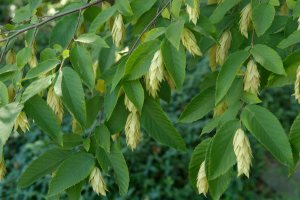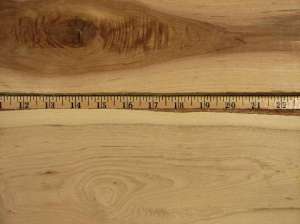I think it was the hophornbeam (Ostrya virginiana) that introduced me to the concept of an “understory” tree. The deciduous hardwood forest consists of at least four tiers: herbaceous “wildflowers” close to the forest floor like sarsaparilla and bracken; shrubs like mountain laurel and spicebush; subcanopy trees like hornbeam and hazelnut; and canopy trees like maples, oaks, and ashes.

The hophornbeam is related to the hornbeam (Carpinus caroliniana)—they are both in the birch (Betulaceae) family—and have similar ovid acuminate leaves with doubly-serrated (teeth on teeth) margins, but as its name suggests Ostrya has fruits that resemble those of the hop plant. These are yellowish green pendant clusters two or three inches long that consist of imbricated “petals” (something like the scales of a pine cone) with green sepals around the base where it attaches to the peduncle. They are fairly large for a temperate tree fruit and easy to spot in the forest during June and July.
In fact, before the fruit are set you might not notice this species at at all. The flowers look like those of other species in the birch family, catkins a few inches long with tiny yellowish flowers arranged along them. The male flowers are slightly showier but the fertilized female flowers form the papery flat sacs around the seeds.

Carpinus has strikingly smooth gray bark and a trunk that resembles a finely toned arm, as if the tree had spent quite a lot of time at the gym, so it tends to be noticed. But Ostrya has finely-scaled brown bark that might a little shaggier than average but frankly looks like a lot of other trees. In a forest where the canopy trees are 60 or 70 feet tall, hophornbeam and other subcanopy trees tend to be about 30 or 40 feet tall, with shrubs like witch-hazel tending to top out at around 15 or 20 feet.
In eastern deciduous forests the canopy trees tend to form a continuous layer of leaves that block most of the light, so sub canopy trees have to be adapted to thriving under lower light conditions. That said, in openings in the canopy produced by wind-fallen trees and stream corridors, many sub canopy trees seem to do quite well. When I was at Lick Brook recently, a Finger Lakes Land Trust property on the east side of the Cayuga valley south of Ithaca, I noticed that the hophornbeams that leaned out over the gorge were much more heavily laden with blossoms than the ones in the understory.
One of the other vernacular names applied to Ostrya is “ironwood” (which is also applied to Carpinus). This is very dense hard wood. The average dried weight is 49 lbs/ft3 (maple is 44 lbs/ft3) and hophornbeam is used for furniture, canes, and tool handles. Wide sapwood is white to pale yellow. Heartwood is a light brown, sometimes with a reddish hue. Overall appearance can be very similar to birch. Carpinus is almost identical to Ostrya in lumber terms.

The hardness is noted in both its vernacular names and the scientific name for the genus. “Beam” is an early English word (through Anglo-Saxon) for a living tree, although it has come to mean a piece of lumber that holds up a roof or forms the structure of a boat. “Horn” is a reference to the hardness of bone or horn, one of the tougher naturally occurring substances known (the “iron” in the other of this tree’s names making the same reference). The genus name is derived from the Greek ostrua, which means “bone-like.”
It is hard because it is slow growing. Trees have indeterminate growth; they will keep growing as long as they live (hence the use of growth rings as in dendrochronology), but at a slower and slower rate as they age. After the maple, ash, and yellow poplar sapling shoot past them to form the canopy overhead, the growth of the hornbeams and other understory trees must slow considerably as less and less light reaches them. Then, once the tiered geometry is establish, they just continue to grow old together.

You must be logged in to post a comment.